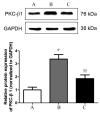Atorvastatin prevents glomerular extracellular matrix formation by interfering with the PKC signaling pathway
- PMID: 29532876
- PMCID: PMC5928626
- DOI: 10.3892/mmr.2018.8724
Atorvastatin prevents glomerular extracellular matrix formation by interfering with the PKC signaling pathway
Abstract
Platelet-activating factor (PAF) promotes glomerular extracellular matrix (ECM) deposition, primarily through activation of the protein kinase C (PKC) pathway. The present study was designed to investigate whether atorvastatin, which mediates a protective effect against glomerular ECM deposition and diabetic neuropathy, may interfere with the PKC‑transforming growth factor‑β1 (TGF‑β1) pathway in a model of human mesangial cells (HMCs) exposed to a high glucose (HG) and lysophosphatidylcholine (LPC) environment. HMCs were divided into three treatment groups: Control, high glucose and lysophosphatidylcholine (HG+LPC), and HG+LPC+atorvastatin. Cells were cultured for 24 h. The levels of the ECM‑associated molecules collagen IV (Col IV) and fibronectin (Fn) in the supernatant were detected using an ELISA kit. PKC‑β1, TGF‑β1 and PAF‑receptor gene expression was detected by reverse transcription‑quantitative polymerase chain reaction. PKC‑β1 and TGF‑β1 protein expression was detected by western blotting, and the subcellular localization of PKC‑β1 was assessed using immunofluorescence. The results indicated that atorvastatin may reduce the secretion of ECM components (Fn and Col IV) in HMCs in a HG and LPC environment, by inhibiting the increase in PAF secretion and the activation of the PKC‑TGF‑β1 signaling pathway.
Keywords: platelet-activating factor; high glucose and lysophosphatidylcholine; protein kinase C; extracellular matrix; atorvastatin.
Figures










Similar articles
-
High glucose/lysophosphatidylcholine levels stimulate extracellular matrix deposition in diabetic nephropathy via platelet‑activating factor receptor.Mol Med Rep. 2018 Feb;17(2):2366-2372. doi: 10.3892/mmr.2017.8102. Epub 2017 Nov 20. Mol Med Rep. 2018. PMID: 29207067 Free PMC article.
-
Lisofylline, a novel antiinflammatory compound, protects mesangial cells from hyperglycemia- and angiotensin II-mediated extracellular matrix deposition.Endocrinology. 2003 Dec;144(12):5227-31. doi: 10.1210/en.2003-0739. Epub 2003 Aug 28. Endocrinology. 2003. PMID: 12960000
-
Inhibition of NADPH Oxidase 5 (NOX5) Suppresses High Glucose-Induced Oxidative Stress, Inflammation and Extracellular Matrix Accumulation in Human Glomerular Mesangial Cells.Med Sci Monit. 2020 Feb 3;26:e919399. doi: 10.12659/MSM.919399. Med Sci Monit. 2020. PMID: 32012145 Free PMC article.
-
Reactive oxygen species as glucose signaling molecules in mesangial cells cultured under high glucose.Kidney Int Suppl. 2000 Sep;77:S19-25. doi: 10.1046/j.1523-1755.2000.07704.x. Kidney Int Suppl. 2000. PMID: 10997686 Review.
-
[Dysfunction of mesangial cell and matrix in progression of diabetic nephropathies].Nihon Rinsho. 2005 Jun;63 Suppl 6:336-40. Nihon Rinsho. 2005. PMID: 15999730 Review. Japanese. No abstract available.
Cited by
-
Pathomechanisms of Diabetic Kidney Disease.J Clin Med. 2023 Nov 27;12(23):7349. doi: 10.3390/jcm12237349. J Clin Med. 2023. PMID: 38068400 Free PMC article. Review.
-
Statins as Secondary Preventive Agent to Limit Breast Cancer Metastatic Outgrowth.Int J Mol Sci. 2025 Feb 3;26(3):1300. doi: 10.3390/ijms26031300. Int J Mol Sci. 2025. PMID: 39941069 Free PMC article. Review.
-
Protective effect of hydrogen sulfide on oxidative stress-induced neurodegenerative diseases.Neural Regen Res. 2020 Feb;15(2):232-241. doi: 10.4103/1673-5374.265543. Neural Regen Res. 2020. PMID: 31552888 Free PMC article.
-
Echinochrome A Prevents Diabetic Nephropathy by Inhibiting the PKC-Iota Pathway and Enhancing Renal Mitochondrial Function in db/db Mice.Mar Drugs. 2023 Mar 30;21(4):222. doi: 10.3390/md21040222. Mar Drugs. 2023. PMID: 37103361 Free PMC article.
-
The role of protein kinase C in diabetic microvascular complications.Front Endocrinol (Lausanne). 2022 Aug 17;13:973058. doi: 10.3389/fendo.2022.973058. eCollection 2022. Front Endocrinol (Lausanne). 2022. PMID: 36060954 Free PMC article. Review.
References
-
- Fragopoulou E, Iatrou C, Antonopoulou S, Ruan XZ, Fernando RL, Powis SH, Moorhead JF, Varghese Z. Platelet-activating factor (PAF) increase intracellular lipid accumulation by increasing both LDL and scavenger receptors in human mesangial cells. J Lab Clin Med. 2006;147:281–289. doi: 10.1016/j.lab.2006.01.004. - DOI - PubMed
MeSH terms
Substances
LinkOut - more resources
Full Text Sources
Other Literature Sources
Miscellaneous

